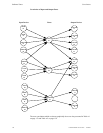
5HDG6WDWXV 2SHUDWLQJ,QVWUXFWLRQV
8QLPRGH31&
Drift Compensation
Drift compensation uses software algorithms that identify and compensate for long-term
changes in the data readings from each addressable smoke detector. These long-term
changes in detector data readings are typically caused by dirt and dust accumulation inside
the smoke chamber. Drift compensation performs the following functions:
• Allows a smoke detector to retain its original ability to detect actual smoke and
resist false alarms, even as dirt and dust accumulate
• Reduces maintenance requirements by allowing the control panel to automatically
perform the periodic sensitivity measurements required by NFPA Standard 72
The FACP software also provides smoothing filters to remove transient noise signals,
usually caused by electrical interference.
Maintenance Alert
The software determines when the drift compensation for a detector reaches an
unacceptable level that can compromise detector performance. When a detector reaches
an unacceptable level, the control panel indicates a maintenance alert. Table 4.1
summarizes the three levels of maintenance alert:
Figure 4.1 illustrates a graphic representation of the maintenance levels:
Maintenance Level FACP Status Display Indicates
Low Chamber Value INVREP A hardware problem in the detector
Maintenance Alert DIRTY1 Dust accumulation that is near but below the
allowed limit. DIRTY 1 indicates the need for
maintenance before the performance of the detector
is compromised
Maintenance Urgent DIRTY2 Dust accumulation above the allowed limit.
Table 4.1 Maintenance Alert Levels
Figure 4.1 Diagram of Maintenance Levels
DIRTY
Acceptable
Range
Maintenance
Urgent
Maintenance
Alert
Low Chamber
Reading
LOW
VA L U E


















